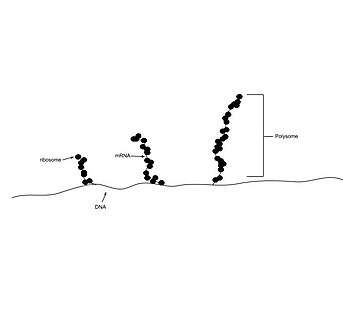Polysome
A polyribosome (or polysome or ergasome) is a group of ribosomes bound to an mRNA molecule like “beads” on a “thread”.[1] It consists of a complex of an mRNA molecule and two or more ribosomes that act to translate mRNA instructions into polypeptides. Originally coined "ergosomes" in 1963, they were further characterized by Jonathan Warner, Paul M. Knopf,[2] and Alex Rich.

Polysomes are formed during the elongation phase when ribosomes and elongation factors synthesize the encoded polypeptide. Multiple ribosomes move along the coding region of mRNA, creating a polysome. The ability of multiple ribosomes to function on an mRNA molecule explains the limited abundance of mRNA in the cell.[3] Polyribosome structure differs between prokaryotic polysomes, eukaryotic polysomes, and membrane bound polysomes.[1] Polysome activity can be used to measure the level of gene expression through a technique called polysomal profiling.[4]
Structure
Electron microscopy technologies such as staining, metal shadowing, and ultra-thin cell sections were the original methods to determine polysome structure. The development of cryo-electron microscopy techniques has allowed for increased resolution of the image, leading to a more precise method to determine structure. Different structural configurations of polyribosomes could reflect a variety in translation of mRNAs. An investigation of the ratio of polyribosomal shape elucidated that a high number of circular and zigzag polysomes were found after several rounds of translation. A longer period of translation caused the formation of densely packed 3-D helical polysomes.[1] Different cells produce different structures of polysomes.
Prokaryotic
Bacterial polysomes have been found to form double-row structures. In this conformation, the ribosomes are contacting each other through smaller subunits. These double row structures generally have a “sinusoidal” (zigzag) or 3-D helical path. In the “sinusoidal” path, there are two types of contact between the small subunits- “top-to-top” or “top-to-bottom”. In the 3-D helical path, only “top-to-top” contact is observed.[1]
Polysomes are present in archaea, but not much is known about the structure.[5]
Eukaryotic
In cells
in situ (in cell) studies have shown that eukaryotic polysomes exhibit linear configurations. Densely packed 3-D helices and planar double-row polysomes were found with variable packing including “top-to-top” contacts similar to prokaryotic polysomes. Eukaryotic 3-D polyribosomes are similar to prokaryotic 3-D polyribosomes in that they are “densely packed left-handed helices with four ribosomes per turn”. This dense packing can determine their function as regulators of translation, with 3-D polyribosomes being found in sarcoma cells using fluorescence microscopy.[1]
Cell free
Atomic force microscopy used in in vitro studies have shown that circular eukaryotic polysomes can be formed by free polyadenylated mRNA in the presence of initiation factor eIF4E bound to the 5’ cap and PABP bound to the 3’-poly(A) tail. However, this interaction between cap and poly(A)-tail mediated by a protein complex is not a unique way of circularizing polysomal mRNA. It has been found that topologically circular polyribosomes can be successfully formed in the translational system with mRNA with no cap and no poly(A) tail as well as a capped mRNA without a 3’-poly(A) tail.[1]
Membrane-bound
Polyribosomes bound to membranes are restricted by a 2 dimensional space given by the membrane surface. The restriction of inter-ribosomal contacts causes a round-shape configuration that arranges ribosomes along the mRNA so that the entry and exit sites form a smooth pathway. Each ribosome is turned relative to the previous one, resembling a planar spiral.[1]
Profiling
Polysomal Profiling is a technique that uses cycloheximide to arrest translation and a sucrose gradient to separate the resulting cell extract by centrifugation.[3] Ribosome-associated mRNAs migrate faster than free mRNAs and polysome associated mRNAs migrate faster than ribosome associated mRNAs. Several peaks corresponding to mRNA are revealed by the measurement of total protein across the gradient. The corresponding mRNA is associated with increasing numbers of ribosomes as polysomes. The presence of mRNA across the gradient reveals the translation of the mRNA. Polysomal profiling is optimally applied to cultured cells and tissues to track the translational status of an identified mRNA as well as measure ribosome density.[4] This technique has been used to compare the translational status of mRNAs in different cell types.
For example, polysomal profiling was used in a study to investigate the effect of vesicular stomatitis virus (VSV) in mammalian cells.[6] The data from polysomal profiling showed that host mRNAs are outcompeted by viral mRNAs for polysomes, therefore decreasing the translation of host mRNA and increasing the translation of viral mRNA.[6]
References
- Afonina ZA, Shirokov VA (January 2018). "Three-Dimensional Organization of Polyribosomes- A Modern Approach". Biochemistry. Biokhimiia. 83 (Suppl 1): S48–S55. doi:10.1134/S0006297918140055. PMID 29544430.
- Cambra K (Spring 2017). "Paul M. Knopf, PhD". Brown Medicine. Brown University. Retrieved 24 July 2017.
- King HA, Gerber AP (January 2016). "Translatome profiling: methods for genome-scale analysis of mRNA translation". Briefings in Functional Genomics. 15 (1): 22–31. doi:10.1093/bfgp/elu045. PMID 25380596.
- Li S, Le B, Ma X, Li S, You C, Yu Y, et al. (December 2016). Qi J (ed.). "Biogenesis of phased siRNAs on membrane-bound polysomes in Arabidopsis". eLife. 5: e22750. doi:10.7554/eLife.22750. PMC 5207768. PMID 27938667.
- French SL, Santangelo TJ, Beyer AL, Reeve JN (April 2007). "Transcription and translation are coupled in Archaea". Molecular Biology and Evolution. 24 (4): 893–5. doi:10.1093/molbev/msm007. PMID 17237472.
- Neidermyer WJ, Whelan SP (June 2019). "Global analysis of polysome-associated mRNA in vesicular stomatitis virus infected cells". PLOS Pathogens. 15 (6): e1007875. doi:10.1371/journal.ppat.1007875. PMC 6608984. PMID 31226162.